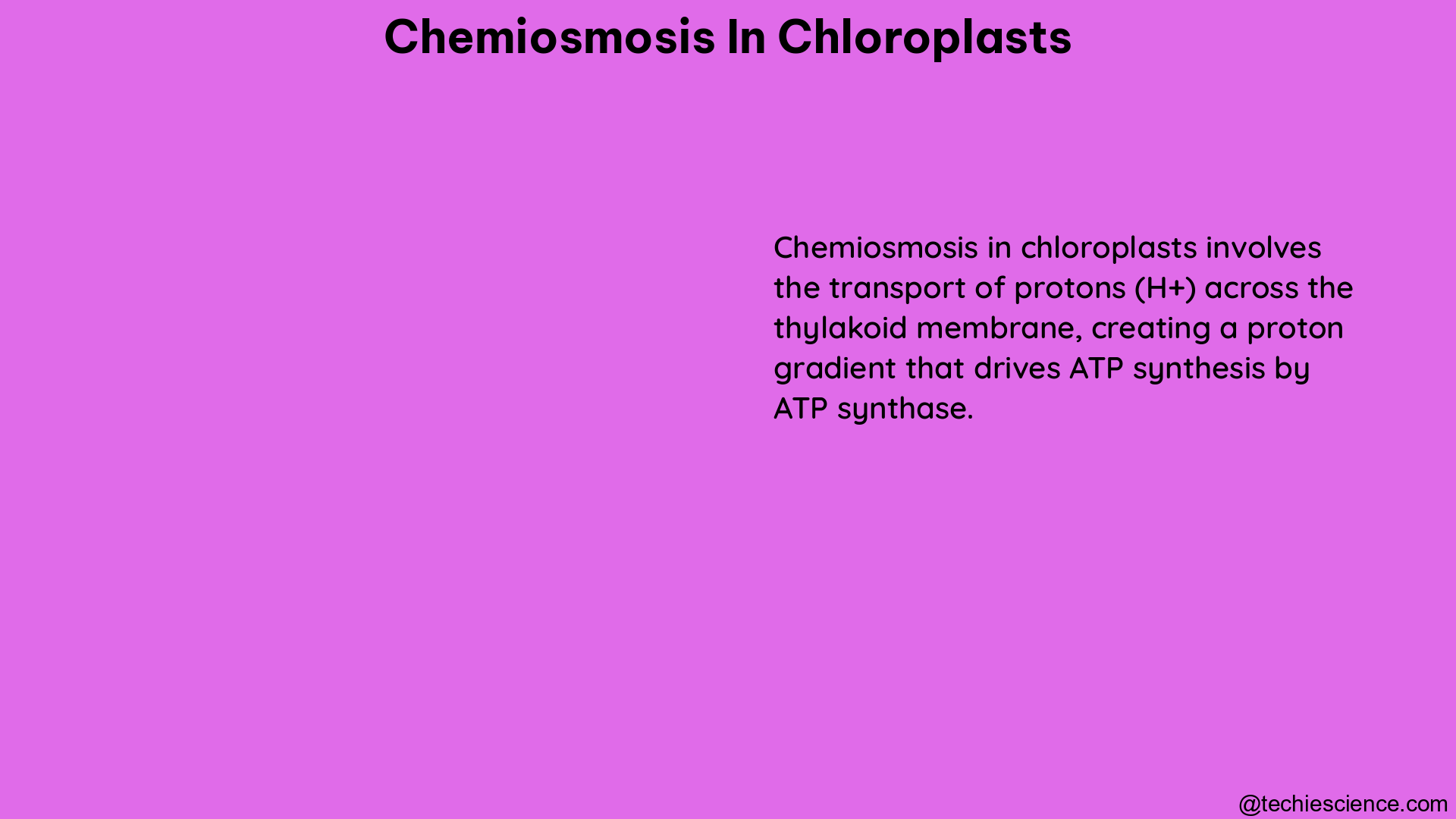Chemiosmosis in chloroplasts is a crucial process in photosynthesis, where the energy from sunlight is converted into chemical energy in the form of ATP. This process is based on the chemiosmotic theory proposed by Peter Mitchell in 1961, which suggests that the energy from the electron transport chain is used to pump protons across the membrane, creating a gradient. The flow of protons back across the membrane through ATP synthase drives the synthesis of ATP.
The Mechanism of Chemiosmosis in Chloroplasts
In chloroplasts, chemiosmosis occurs in the thylakoid membrane, where the light-dependent reactions of photosynthesis take place. The electron transport chain in the thylakoid membrane drives the pumping of protons (H+ ions) from the stroma (the fluid-filled space surrounding the thylakoid membrane) into the thylakoid lumen (the space inside the thylakoid membrane), creating a proton gradient.
The key steps in the chemiosmotic process in chloroplasts are:
-
Electron Transport Chain: The electron transport chain, which includes a series of electron carriers such as photosystem II, cytochrome b6f complex, and photosystem I, transfers electrons from water to NADP+. This process releases energy that is used to pump protons (H+ ions) from the stroma into the thylakoid lumen.
-
Proton Gradient Formation: The pumping of protons into the thylakoid lumen creates a proton gradient, with a higher concentration of protons in the lumen compared to the stroma. This proton gradient is the driving force for the synthesis of ATP.
-
ATP Synthase: The protons flow back from the thylakoid lumen to the stroma through the enzyme ATP synthase, which is embedded in the thylakoid membrane. The energy released by the flow of protons is used to drive the synthesis of ATP from ADP and inorganic phosphate (Pi).
-
ATP Production: The ATP produced in the thylakoid lumen is then transported to the stroma, where it is used in the light-independent reactions of photosynthesis (also known as the Calvin cycle) to convert carbon dioxide into organic compounds, such as glucose.
Evidence for Chemiosmosis in Chloroplasts

One of the key pieces of evidence for the chemiosmotic theory in chloroplasts is the “acid-bath experiment” conducted by Uribe and Jagendorf in the 1960s. In this experiment, the inner space of the grana disk membranes of spinach chloroplasts was loaded with protons in the dark and without electron transport, resulting in the generation of ATP. This experiment demonstrated that a proton gradient alone can drive the synthesis of ATP, supporting the chemiosmotic theory.
Another important piece of evidence is the determination of the structures of the proteins involved in the chemiosmotic mechanism, including the ATP synthase and the components of the electron transport chain. These structural studies have provided detailed insights into the molecular mechanisms of chemiosmosis in chloroplasts.
Quantifiable Data on Chemiosmosis in Chloroplasts
-
Proton Motive Force (PMF): The proton motive force (PMF) across the thylakoid membrane can be measured in millivolts (mV) and is typically around 150-200 mV in chloroplasts. The PMF is the driving force for the flow of protons through ATP synthase and the synthesis of ATP.
-
Rate of ATP Synthesis: The rate of ATP synthesis can be measured and is typically around 3-4 ATP molecules synthesized per second per ATP synthase complex in chloroplasts.
-
Proton Concentration Gradient: The concentration of protons (H+ ions) in the thylakoid lumen can be up to 1,000 times higher than in the stroma, creating a steep proton gradient that drives the synthesis of ATP.
-
Membrane Potential: The difference in electrical potential across the thylakoid membrane, known as the membrane potential, can be measured and is typically around -120 to -180 mV, with the lumen being more positive than the stroma.
-
Efficiency of ATP Synthesis: The efficiency of ATP synthesis in chloroplasts is estimated to be around 50-60%, meaning that approximately half of the energy released by the flow of protons through ATP synthase is converted into ATP.
Conclusion
Chemiosmosis in chloroplasts is a fundamental process in photosynthesis, where the energy from sunlight is converted into chemical energy in the form of ATP. This process is based on the chemiosmotic theory proposed by Peter Mitchell and is supported by various experimental evidence, including the “acid-bath experiment” and the determination of the structures of the proteins involved in the chemiosmotic mechanism.
The quantifiable data on the proton motive force, rate of ATP synthesis, proton concentration gradient, membrane potential, and efficiency of ATP synthesis provide valuable insights into the intricate details of this crucial process in chloroplasts. Understanding the mechanisms and dynamics of chemiosmosis in chloroplasts is essential for advancing our knowledge of photosynthesis and its applications in fields such as renewable energy, agriculture, and biotechnology.
References:
– Mitchell, P. (2011). Chemiosmotic coupling in oxidative and photosynthetic phosphorylation. Biochimica et Biophysica Acta (BBA) – Bioenergetics, 1807(12), 1297-1317.
– Chemiosmosis – an overview | ScienceDirect Topics. (n.d.). Retrieved July 8, 2024, from https://www.sciencedirect.com/topics/agricultural-and-biological-sciences/chemiosmosis
– Is Chemiosmosis a hypothesis or a theory, and what experiment has been performed to test it? – Biology Stack Exchange. (n.d.). Retrieved July 8, 2024, from https://biology.stackexchange.com/questions/111487/is-chemiosmosis-a-hypothesis-or-a-theory
– bio exam 4 Flashcards | Quizlet. (n.d.). Retrieved July 8, 2024, from https://quizlet.com/727312875/bio-exam-4-flash-cards/
– Two Experiments Demonstrate the Chemiosmotic Mechanism. (n.d.). Retrieved July 8, 2024, from http://digitalfirst.bfwpub.com/life_11e_animation/life_animation_09_02.html
Hi, I am Sayantani Mishra, a science enthusiast trying to cope with the pace of scientific developments with a master’s degree in Biotechnology.